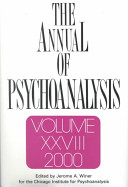
The Annual of Psychoanalysis
By - Winer, Jerome A.Call Number – 100 ANN
Physical Description – x, 274pages: illustrations; 24 cm.
Notes – Includes Bibliographical References and
Index.
Volume 28 of The Annual features stimulating original essays on the relationship between psychoanalysis and the neurosciences. Edelman's Neural Darwinism informs Barry's Investigaton of the psychoanalytic theory of internalization and Fajardo's reassessment of "breaks in consciousness" whereas Gedo's hierarchical model of mental functioning informs Fisher's presentation of the treatment of an autistic child. Elsewhere, Hadley proposes a neurobiologically distinct motivational system devoted to the development of autonomy; Solms attempts to bridge psychoanalysis and the neurophysiology of dreaming; Levin and Trevarthen examine the relationship of conscious and unconscious functions to the executive control network (ECN) of the brain; Levin examines the contributions of chaos theory to psychoanalysis; and Modell explores metaphor as the crucial aspect of the developing mind and brain through which cognition itself occurs. Moraitis's examination of why analysis has been so slow to integrate its findings with the insights of contemporary neuroscience and cognitive psychology, and Sadow's reprise on the role of theory in the evolution of psychoanalysis usefully frame the contributions to this section. Section II of Volume 28 reengages a subject area for which The Annual has become well-known. The four characteristically excellent studies in applied psychoanalysis found here cover the effect of early father loss on the work of the American watercolorist Charles Burchfield, "The Creativity of Women," the unconscious influence of metaphor on attitudes and value judgments, and the application of self psychology to the dramas of Eugene O'Neill. It is altogether typical of this fine series that a collection of essays dedicated to the development of a psychobiologically sophisticated psychoanalysis should be followed by contributions that testify to the explanatory vitality of psychoanalysis with respect to issues of literature, art, and creativity.